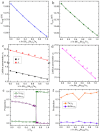Realization of tunable Dirac cone and insulating bulk states in topological insulators (Bi(1-x)Sb(x))(2)Te(3)
- PMID: 23240080
- PMCID: PMC3521154
- DOI: 10.1038/srep00976
Realization of tunable Dirac cone and insulating bulk states in topological insulators (Bi(1-x)Sb(x))(2)Te(3)
Abstract
The bulk-insulating topological insulators with tunable surface states are necessary for applications in spintronics and quantum computation. Here we present theoretical evidence for modulating the topological surface states and achieving the insulating bulk states in solid-solution (Bi(1-x)Sb(x))(2)Te(3). Our results reveal that the band inversion occurs in (Bi(1-x)Sb(x))(2)Te(3), indicating the non-triviality across the entire composition range, and the Dirac point moves upwards till it lies within the bulk energy gap accompanying the increase of Sb concentration x. In addition, with increasing x, the formation of prominent native defects becomes much more difficult, resulting in the truly insulating bulk. The solid-solution system is a promising way of tuning the properties of topological insulators and designing novel topologically insulating devices.
Figures





Similar articles
-
Tunable Dirac cone in the topological insulator Bi(2-x)Sb(x)Te(3-y)Se(y).Nat Commun. 2012 Jan 24;3:636. doi: 10.1038/ncomms1639. Nat Commun. 2012. PMID: 22273674
-
Band structure engineering in (Bi(1-x)Sb(x))(2)Te(3) ternary topological insulators.Nat Commun. 2011 Dec 6;2:574. doi: 10.1038/ncomms1588. Nat Commun. 2011. PMID: 22146393
-
Terahertz conductivity of topological surface states in Bi₁.₅Sb₀.₅Te₁.₈Se₁.₂.Sci Rep. 2013 Dec 17;3:3513. doi: 10.1038/srep03513. Sci Rep. 2013. PMID: 24343202 Free PMC article.
-
The effect of charged particle irradiation on the transport properties of bismuth chalcogenide topological insulators: a brief review.Phys Chem Chem Phys. 2024 Jan 24;26(4):2745-2767. doi: 10.1039/d3cp02462h. Phys Chem Chem Phys. 2024. PMID: 38179833 Review.
-
Topological insulators for thermoelectrics: A perspective from beneath the surface.Innovation (Camb). 2025 Jan 22;6(3):100782. doi: 10.1016/j.xinn.2024.100782. eCollection 2025 Mar 3. Innovation (Camb). 2025. PMID: 40098672 Free PMC article. Review.
Cited by
-
Large gap Quantum Spin Hall Insulators of Hexagonal III-Bi monolayer.Sci Rep. 2016 Oct 7;6:34861. doi: 10.1038/srep34861. Sci Rep. 2016. PMID: 27713518 Free PMC article.
-
Phase transitions, Dirac and Weyl semimetal states in Mn1-xGexBi2Te4.Sci Rep. 2025 Jan 11;15(1):1741. doi: 10.1038/s41598-024-73267-1. Sci Rep. 2025. PMID: 39799224 Free PMC article.
-
Prolonged duration of nonequilibrated Dirac fermions in neutral topological insulators.Sci Rep. 2017 Oct 26;7(1):14080. doi: 10.1038/s41598-017-14308-w. Sci Rep. 2017. PMID: 29074864 Free PMC article.
References
-
- Moore J. E. The birth of topological insulators. Nature (London) 464, 194–198 (2010). - PubMed
-
- Hasan M. & Kane C. Colloquium: Topological insulators. Rev. Mod. Phys. 82, 3045–3067 (2010).
-
- Qi X.-L. & Zhang S.-C. Topological insulators and superconductors. Rev. Mod. Phys. 83, 1057–1110 (2011).
-
- Bernevig B. A., Hughes T. L. & Zhang S. C. Quantum spin Hall effect and topological phase transition in HgTe quantum wells. Science 314, 1757–1761 (2006). - PubMed
-
- Zhang H. et al. Topological insulators in Bi2Se3, Bi2Te3 and Sb2Te3 with a single Dirac cone on the surface. Nat. Phys. 5, 438–442 (2009).
LinkOut - more resources
Full Text Sources
Miscellaneous

